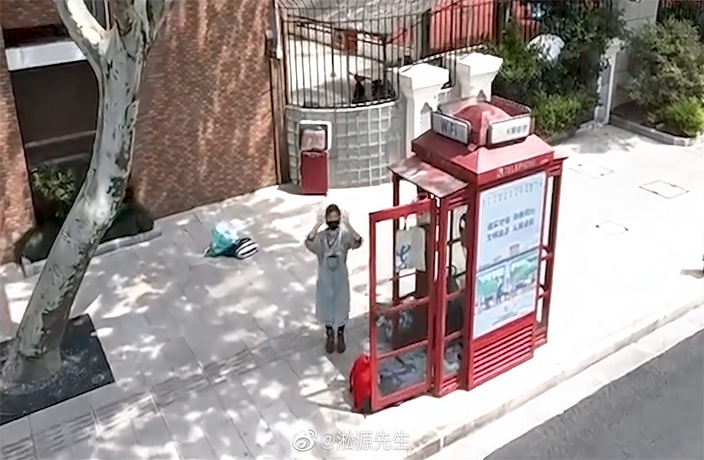Shanghai, China’s most populated and richest city, has been under full-scale lockdown since early April and some residents have even been confined to their homes for almost two months.
One woman, reportedly a migrant worker, didn’t have a place of permanent residence when the city of nearly 25-million people went into lockdown and she was therefore, left on the streets.
The woman, who has not been named but is said to be in her 50s, took shelter in a phone booth by the side of the road. She spent her days doing laundry, which she hung on a drying rack outside the phone booth, and walking her dog.
Her situation came to light when a resident in a nearby apartment block saw that she was living out of the nearby telephone box and documented her daily life by posting pictures of her on Chinese social media.
The series of photos sparked anger from Chinese netizens as they questioned how someone could be left behind to wander the streets during a city-wide lockdown.
The photos posted on social media show that the woman appears to be well kept and makes a strong effort to keep on top of her appearance, despite being homeless.
The woman told China Youth Daily, “the phone booth is located in a very tranquil school area. Although it’s only one square meter, it’s free and fit for one person. I enjoy it. I live a simple life and I have enough food and clothes. As long as I’m healthy, everything is fine.”
When the images of the woman went viral on Chinese social media, authorities asked the woman to leave, but she refused. Later, the phone box was taped up. Unable to enter, she was forced to find somewhere else to live.
Migrant workers have also been referred to as China’s “floating population.” China had around 286 million migrant workers in 2020, consisting of one-third of the Chinese labor force.
READ MORE: Why China’s Gig Economy is on the Rise
The near 300 million people often drift from city to city, mainly working in construction, service jobs and factory assembly lines.
China's floating population man the restaurants we eat in, build the skyscrapers we live and work in, and assemble the phones we use every day. They keep the country moving.
Like everything else, COVID-19 has had an effect on migrant workers too. As lockdowns are imposed, construction is halted, factories are closed and retail shuts down. This leaves the floating population, who make an average of just over RMB4,000 per month, particularly vulnerable.
Not only do temporary lockdowns hit migrant workers hard, but the economic downturn and regulations that we have seen since COVID-19 was first found in 2020 has caused sectors to shrink, leading to a decrease in the demand for workers.
However, that means that there is one area that is growing – COVID.
Now, migrant workers are often being employed and moving from lockdown city to lockdown city as dabai (big whites). From construction workers to healthcare workers, is there anything that the floating population can't do?
But of course, the dangers of working as a dabai are evident.
Chen, a migrant worker stationed in one of Shanghai’s exhibition centers told NPR that the conditions were appalling.
"I am worried that they cannot guarantee my own health. There are workers who have tested positive for COVID but we sleep next to them. The infected workers have simply been reassigned to work as guards or trash pickers for the expo center rather than tending to people inside."
China’s floating population is regularly exposed to poor conditions. Migrant workers (who are on average in their early 40s) often live in dorms near their place of work, usually with at least four people per room and have poor healthcare.
Due to the fact that migrant workers jump from city to city, it is estimated that they leave behind around 40.5 million children, who are in turn raised by grandparents or one parent.
Migrant workers will then send money home to support their children, but is their salary enough? A worker by the name of Xu Qiangwei told The World of Chinese that he made RMB7,000 per month in Shanghai (much more than the RMB4,000 average ).
“In Shanghai, you can’t really have savings if you only make RMB7,000 a month. After I subtract rent, cigarettes, clothes and personal expenses, there’s nothing left. Sometimes I have to pick up part-time jobs at the courier company if I’m broke.”
However, due to the lockdown in Shanghai right now, finding full-time work, let alone something on the side, is hard enough.
There are rumors that, if 'zero-COVID' is achieved, Shanghai will begin opening up by the end of May, a move that will undoubtedly help both Chinese citizens and the economy.
People like the woman in the phone box will be remembered because she was out in the streets for all to see, but we shouldn't forget about the 300 million that are hiding in plain sight. The longer lockdown goes on, the longer they will feel the squeeze.
[Cover image via Weibo@淞源先生]





















0 User Comments